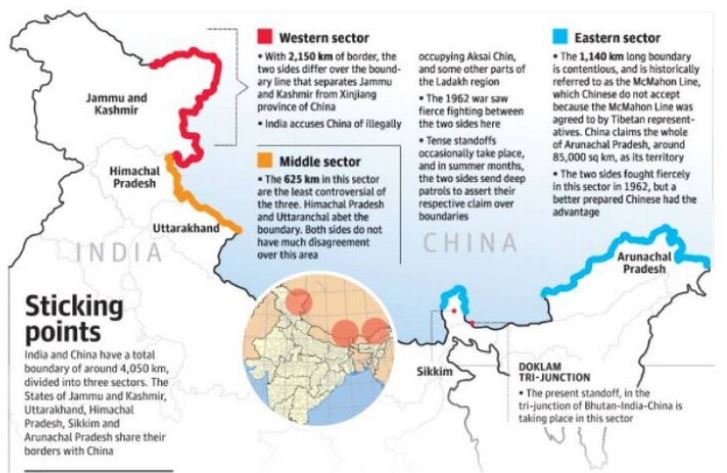INDIA CHINA BORDER DISPUTE
2020 MAY 13
Mains >
International relations > India and Neighbours > India-China

IN NEWS:
- Border patrols from India and China have been involved in a series of incidents along their disputed boundary.
HISTORY:
- Traditionally, the Himalayas acted as a natural boundary separating the two regions.
- Today, the two nations share a highly disputed 3488 km border. The Line of Actual Control (LAC), formed after the 1962 war, separates Indian-controlled territory from Chinese-controlled territory.
- 4 states viz., Himachal Pradesh, Uttarakhand, Sikkim and Arunachal Pradesh and Union Territories of Ladakh (erstwhile state of Jammu & Kashmir) share a border with China.

WESTERN SECTOR:
- In the western sector, Union Territory of Ladakh shares about 2152 km long border the Xinjiang Province of China.
- Aksai Chin is the most disputed region in this sector. The dispute arises from a cartographic uncertainty.
- The Johnson’s line, proposed in 1865, shows Aksai Chin in erstwhile Jammu and Kashmir, thereby bringing it under India’s control. Upon independence, India used the Johnson Line as the basis for its official boundary in the west.
- However, the McDonald Line, proposed in 1893, places the region under China’s control.
CENTRAL SECTOR:
- Here, India shares about 625 km long boundary with China. This region, passing along Himachal Pradesh and Uttarakhand remain largely peaceful.
EASTERN SECTOR:
- Here, Sikkim and Arunachal Pradesh share a 1140 km border with China.
- The region is demarcated based on the McMahon line signed between British India and the erstwhile Tibetan government.
- China does not accept the McMahon Line, claiming that Tibet was never a sovereign region to sign such an agreement. Today, it claims almost whole of Arunachal Pradesh.
WHY THEY REMAIN UNRESOLVED:
- Geographical constrains: The rugged mountain range, with its inhospitable climate and undulating topography, is difficult to access and properly demarcate.
- Cartographic issues: The British-era agreements and maps have many unmarked and arbitrarily marked areas. Also, many of these agreements were signed with regional rulers and kingdoms, whose legitimacy is questioned by the modern-day republics.
- Pressure tactic: China settled its border disputes with Nepal, Myanmar, Pakistan, and Afghanistan back in the 1960s itself. However, it has left the dispute with India remain unsettled as a pressure tactic. The Chinese aggression along Doklam in 2017 immediately after India’s aversion to the Belt and Road Summit is an example of this.
- China Pakistan relations: Pakistan and China share deep ties, through military cooperation and strategic projects such as the China Pak Economic Corridor. If China is to settle its disputes with India along the Western sector, it would significantly weaken Pak’s claim over the Kashmir region.
- Commitment Problem: In the long term, China aims for a “Multipolar world, Unipolar Asia”, placing itself as the regional giant in Asia. However, it contradicts India’s view of a “Multipolar world, Multipolar Asia”. Hence, both countries are reluctant fully to cooperate with each other.
- Lack of mutual trust: Historically, Chinese diplomacy has been an unreliable for India. Also, China is suspicious of India’s close ties with the USA. Hence, there is a trust deficit among the two neighbors hindering any form of resolution.
- Other contentious issues: China’s stand on the Tibetan and Kashmir issue, its support for Pakistan in the global fora, the ‘water bomb’ threat to India, China’s stand against India’s NSG membership etc. are barriers to peaceful resolution of the dispute.
- Ultra-nationalism: Although the frontiers in question date back to the British colonial era, the modern phenomenon of social media-fuelled nationalism is a major barrier to progress. Because of their opposing ideological stands, both governments are unwilling to compromise on their demands on territorial rights.
MEASURES TAKEN BY INDIA:
- Investments: To match the huge Chinese investments along the borders, India has been making steady progress in developing critical border infrastructure. It has completed 74 strategic roads, bridges and communication infrastructure along the eastern border. To further expedite border road construction, Ministry of Defence has delegated administrative and financial powers to the Border Roads Organisation (BRO).
- Defensive measures: India has developed the Indo-Tibetan Border Police (ITBP) for deployment along the Tibetan border. To strengthen its border forces, India is deploying its second squadron of Rafale jets at Hasimara base in West Bengal.
- International cooperation: India has joined hands with Japan for aggressively developing infrastructure projects in North east to contain China. India is also pushing for the Kaladan Multimodal project to improve connectivity to the North East.
WAY FORWARD:
- Through the Wuhan Spirit, India and China have been able to make remarkable progress in bilateral relations. However, this has not materialized into resolving the border issues. This has resulted in recurring disputes as well as increased military spending along the borders.
- Ultimately, a peaceful resolution of the disputes can only happen through political consultations. But this requires serious commitment from both the countries.
- Till then, the best way to guarantee peace and tranquility on the border is to focus on proper military-to-military communication, which would allow the two sides to immediately clarify any relevant issues.
PRACTICE QUESTION:
Q. Despite completing seven decades of diplomatic relations, India and China continue to share a highly disputed border. Discuss the causes for this long-lasting dispute. What measures have India taken to address this?
